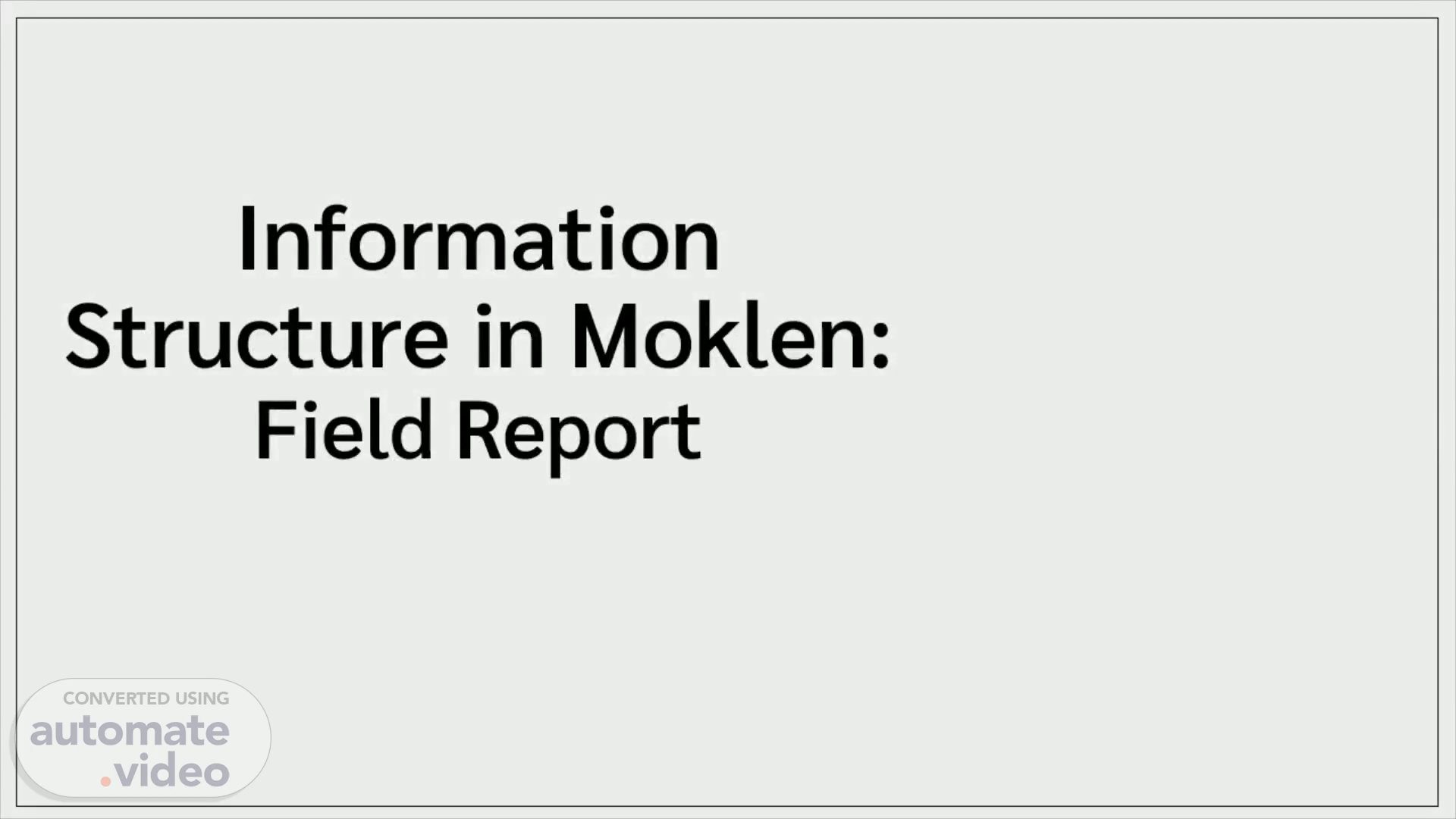
Page 1 (0s)
[Audio] This is an automated draft of my DDS presentation Information Structure in Moklen. I plan to give the full version of this presentation live..
Page 2 (12s)
[Audio] Moklen is a highly endangered, lesser-described language of southern Thailand. Any research on Moklen aor Moken the two Moklenic languaegs is therefore highly valuable..
Page 3 (27s)
[Audio] Moklen is an Austronesian language. Austronesian languages are noteworthy in that the majority of the languages arrived in their present locations as a result of the Austronesian expansion, a sea-going migration over thousand of years..
Page 4 (43s)
[Audio] Modern Moklen communities are now in Phang Nga and Phuket provinces. They are usually nearby the sea where they still harvest sea-life for their own consumption..
Page 5 (1m 2s)
[Audio] I have made four trips to Moklen communities. Due to COVID opportunities for extensive fieldwork have been limited, but earlier this year I was able to conduct some targeted data collection..
Page 6 (1m 20s)
[Audio] One area I'm interested in is Argument Structure or ' word order'. Swastham 1982 reports that there are several variant argument structures which are possible. Additionally, Larish 1999 says that Moklen constructions are in large part congruent with Thai, but like Swastham his data was based on direct elicitation..
Page 7 (1m 45s)
[Audio] Data for language documentation can take many forms, as previous research was based on direct elicitation, I wanted to move to more natural like speech but also target some particular areas of the language therefore I decided to record 'staged communicative events' which used custome-designed field stimuli..
Page 8 (2m 5s)
[Audio] My area of interest generally is INFORMATION STRUCTURE. This area of research is a branch of discourse pragmatics which looks at how cognitive factors relating to the transfer of information during communication affect linguistic structures..
Page 9 (2m 22s)
[Audio] To study Moklen argument structure in the field I came up with the TRANSITIVE EVENT PICTURE SEQUENCES field stimulus..
Page 10 (2m 34s)
[Audio] Using simple illustrations this stimulus has speakers describe several three-picture sequences. Each sequence unfolds through a CONTEXT SCENE, a TARGET SCENE, and a RESOLUTION SCENE. However, by using different context scenes, each sequence can either begin with the AGENT or the PATIENT of the following transitive event..
Page 11 (2m 58s)
[Audio] By creating different conditions with the context scene, the aim is to see how speakers manage contrasting contexts of 'new' and 'given' information in the target scene. And hopefully, these conditions allow for assessment of hypotheses about argument structure and information structure..
Page 12 (3m 17s)
[Audio] I came up with a total of 24 custom sequences to be included in the instrument and I'll be sharing some of these sequences later..
Page 13 (3m 29s)
[Audio] I then took the sequences and then ordered them into contrasting sets..
Page 14 (3m 42s)
[Audio] These then went into 4 different picture books which were to be used into the field..
Page 15 (3m 49s)
[Audio] After a brief training session I conducted the sessions with individual Moklen speakers. Session were recorded with audio and video devices..
Page 16 (4m 1s)
[Audio] In total I selected 16 sessions for analysis of the research questions..
Page 17 (4m 45s)
[Audio] Let's take a look at some example responses while thinking about Moklen argument structure. Here are a few questions to consider while we go through these examples..
Page 18 (4m 59s)
[Audio] EXAMPLE 1. A picture containing fruit, vegetable Description automatically generated.
Page 19 (5m 7s)
[Audio] EXAMPLE 2. A picture containing fruit Description automatically generated.
Page 20 (5m 14s)
[Audio] EXAMPLE 3. A picture containing text Description automatically generated.
Page 21 (5m 22s)
[Audio] EXAMPLE 4. A picture containing text, bed Description automatically generated.
Page 22 (5m 29s)
[Audio] EXAMPLE 5. .
Page 23 (5m 35s)
[Audio] EXAMPLE 6. A picture containing sport Description automatically generated.
Page 24 (5m 43s)
[Audio] Analysis is still ongoing but for a general picture I provided this wordcloud. From my preliminary analysis I can confirm that Canonical order is SVO and that Moklen speakers commonly use zero-anaphora.
Page 25 (5m 59s)
[Audio] With my research, argument structure is actually only a part of my interest..
Page 26 (6m 22s)
[Audio] Something else I'm interested in is the relationship between changes in information status and Moklen word-form. And my hypothesis is that use of monosyllabic alternants —of canonically disyllabic forms— will correspond to 'given' information statuses..
Page 27 (6m 45s)
[Audio] EXAMPLE 7A. A picture containing engineering drawing Description automatically generated.
Page 28 (7m 4s)
Communication is an additive process of signaling ‘new’ and ‘old’ information..
Page 29 (7m 27s)
[Audio] EXAMPLE 7B. A picture containing engineering drawing Description automatically generated.
Page 30 (7m 47s)
[Audio] Larish 1999 previously phrased the alternation as being due to Moklen having 'optional' minor syllables, but I would like add that perhaps there's more to this..
Page 31 (7m 59s)
[Audio] The significance of this is that the change from disyllabic to monosyllabic can be understood at three different, yet related time-frames. I would like to argue that an enchronic time-frame highlights information structure factors which are significant..
Page 32 (8m 16s)
ʔanaːt 'offspring' ʔɛkaːn 'fish' niʔuːn 'coconut' ʔɔmaːk 'house' ʔuʔeːn 'water' pɔkɔn 'tree' niduːn 'sleep' ʔɔlaːn 'snake' mataj 'to die' təpaːʔ ‘to puncture’ cʰuwiək 'fishhook' canaːt 'child' kətaːm 'crab' nəŋɛːn 'to chase' ʔapɔŋ 'father' ləpɔk 'to launder' ʔɛbaːp 'male' kɛcɔk 'bottle' kəpʰlat 'to fall' bəkah 'to break' ticum 'bird' saʔdut 'to trip' nəŋɔːʔ 'to see' mataːʔ 'eye' kəpʰlaːt 'to fall' buwaːk 'fruit' məʔiəŋ 'to roast' bətok 'to strike' nəbut 'to run' ʔibum 'female' dalam 'in' məʔam 'to drink' nəmet ‘ to.dispose ’ paʔɔːk 'mango' dataː 'on' kaʔɛːw 'wood' naŋit 'to cut' nəmɔh 'to fall' mətɛt 'to cut' kabaŋ 'boat'.